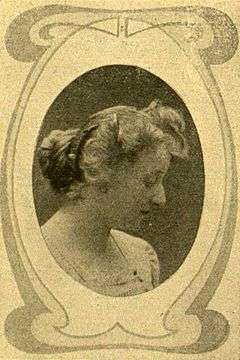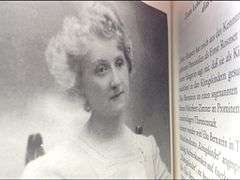Elsa Bernstein
| Elsa Bernstein | |
|---|---|
 | |
| Born |
Else Porges October 28, 1866 Vienna |
| Died |
July 2, 1949 (aged 82) Hamburg-Eimsbüttel |
| Nationality | Austrian-German |
| Other names | Ernst Rosmer |
| Occupation | writer, playwright |
| Notable work | Königskinder |
| Spouse(s) | Max Bernstein |
| Parent(s) | Heinrich Porges |
Else/Elsa Porges-Bernstein (born Else Porges, pseudonym: Ernst Rosmer; October 28, 1866 - July 2, 1949) was an Austrian-German writer and dramatist of Jewish descent.
Life
Elsa Porges was born in Vienna, a daughter of Heinrich Porges (himself a close friend of Richard Wagner). At age 10 and at her own insistence, she attended the first complete four-opera performance of The Ring Cycle in Bayreuth in 1876, for which her father served as Wagner's special documentarian-archivist. Elsa was the cycle's youngest audience member.
With her marriage to journalist Max Bernstein. she became host to one of the most notable musical and literary salons of the late 19th-early 20th century, whose attendees at various times included Gerhart Hauptmann (whose son married Bernstein's daughter, Eva), Hugo von Hofmannsthal, Engelbert Humperdinck, Henrik Ibsen, Annette Kolb, Hermann Levi, Gustav and Alma Mahler, Thomas Mann, Rainer Maria Rilke, Richard Strauss, Bruno Walter and Max Weber, among many others.

She was educated at Munich and, for a short time, on the stage. A degenerative affliction of the eyes forced her to retire, and she thenceforth devoted herself to dramatic literature. Shortly after her marriage in 1892 to Max Bernstein, she wrote her first play, "Wir Drei" (English: "We Three"), which created considerable discussion; some saw it as a dramatization of the matrimonial and sexual views of Taine and Zola. (Although written under the pseudonym of Ernst Rosmer, her identity as the play's author was never secret.) Her next few plays fell short of exciting the same public attention: "Dämmerung" ("Twilight", 1893); "Die Mutter Maria," 1894; "Tedeum" (1896); "Themistokles" (1897); and Daguy Peters.
But unbounded admiration was elicited by Königskinder (1895), a dramatic fairy-tale. Though its plot was simple, the beauty of the theme and its poetry were such as to class it with Ludwig Fulda's Der Talisman." Although Engelbert Humperdinck was dissatisfied with his first concert setting of Königskinder in 1897, an avant-garde melodrama which demanded an innovative "speak-singing" technique from its soloists (despite production challenges, it nevertheless enjoyed over 120 performances across Europe), he persuaded Bernstein in 1907 to authorize a traditional opera setting which debuted in German at the Metropolitan Opera in New York in December 1910. That version is still performed.
Almost certainly at the instigation of Winifred Wagner, Bernstein was awarded an exit visa for the United States in 1941, but refused to leave her sister Gabriele behind (who as Elsa had lost almost all her eyesight, had become her caretaker). The two women were transported to Dachau arriving 25 June 1942, where Bernstein was recognized as the author of Königskinder; as a result, the sisters were sent the following day to Theresienstadt (where Bernstein's sister and caretaker, Gabriele, died). After her liberation in 1945 Bernstein wrote, on a special typewriter for the blind, a detailed account of her confinement in the camp's Prominentenhaus, or "House of Notables." The typescript was discovered by accident and published in German more than five decades after her death.
Bernstein died, aged 82, in Hamburg-Eimsbüttel. Although buried in a grave with her husband, her name is no longer legible on their shared headstone.
Literary works

- Under the pseudonym "Ernst Rosmer"
- Dämmerung (Schauspiel, 1893)
- Wir Drei (Drama 1893)
- Madonna (Novellen 1894)
- Königskinder (Märchendrama 1895; 1895 von Engelbert Humperdinck vertont)
- Tedeum (Komödie 1896)
- Themistokles (Tragödie 1897)
- Mutter Maria. Totengedicht in fünf Wandlungen (1900)
- Merete (1902)
- Dagny (drama) (Drama 1904)
- Johannes Herkner (Schauspiel 1904)
- As "Elsa Bernstein"
- Nausikaa (Tragödie 1906)
- Maria Arndt (Schauspiel 1908)
- Achill (Tragödie 1910)
- Das Leben als Drama. Erinnerungen an Theresienstadt (Tagebuch aus dem KZ, posthum 1999)
References
- Jürgen Joachimsthaler: Max Bernstein. Kritiker, Schriftsteller, Rechtsanwalt (1854-1925). Frankfurt/M. et al. 1995. Biography about her husband, containing a lot of biographical material about her as well.
- Ulrike Zophoniasson-Baierl: Elsa Bernstein alias Ernst Rosmer. Bern et al. 1985.
Bibliography of the Jewish Encyclopedia
- Das Jüngste Deutschland, pp. 317–320;
- Kürschner, Deutscher Litteratur-Kalender, 1901, p. 91;
- Lexikon Deutscher Frauen der Feder, i. 61;
- ib. ii. 203.S
 This article incorporates text from a publication now in the public domain: Isidore Singer & Edgar Mels (1901–1906). "Elsa Bernstein". In Singer, Isidore; et al. Jewish Encyclopedia. New York: Funk & Wagnalls Company.
This article incorporates text from a publication now in the public domain: Isidore Singer & Edgar Mels (1901–1906). "Elsa Bernstein". In Singer, Isidore; et al. Jewish Encyclopedia. New York: Funk & Wagnalls Company.